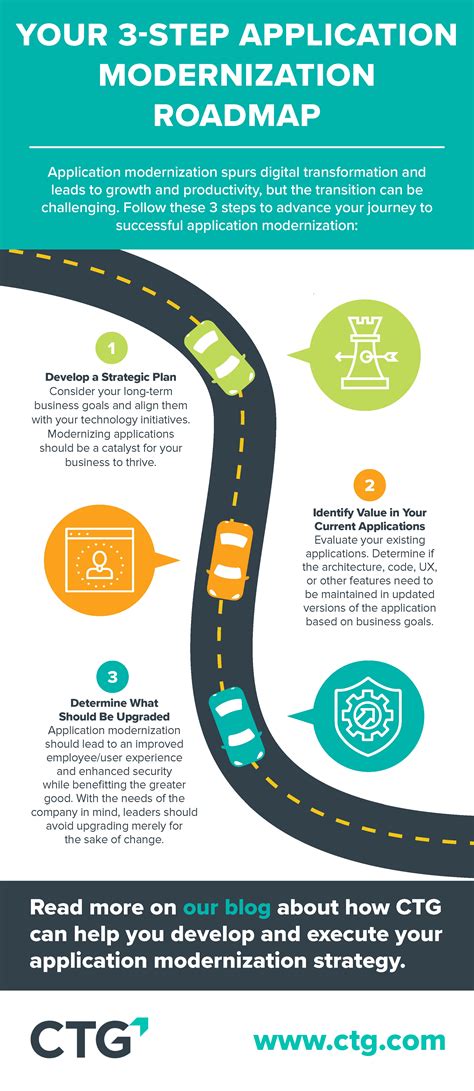In today's fast-paced digital landscape, application modernization is crucial for businesses to stay competitive and relevant. Legacy applications can hinder innovation, increase maintenance costs, and pose security risks. However, modernizing applications can be a daunting task, especially for large-scale and complex systems. To help you navigate this process, we have outlined a 7-step guide to ensure application modernization success.
Understanding the Importance of Application Modernization

Before diving into the steps, it's essential to understand why application modernization is vital. Legacy applications can lead to decreased productivity, increased downtime, and security vulnerabilities. Modernizing applications enables businesses to improve user experience, reduce costs, and increase agility.
Step 1: Assess Your Current Application Landscape
Assess Your Current Application Landscape

The first step in application modernization is to assess your current application landscape. This involves identifying the applications that need modernization, their complexity, and the resources required. You should also evaluate the applications' functionality, user experience, and technical debt.
- Identify the applications that need modernization
- Evaluate the complexity of each application
- Assess the resources required for modernization
- Evaluate the functionality, user experience, and technical debt of each application
Step 2: Define Your Modernization Strategy
Define Your Modernization Strategy

Once you have assessed your application landscape, define your modernization strategy. This involves determining the approach, timeline, and budget for modernization. You should also identify the stakeholders involved and their roles and responsibilities.
- Determine the modernization approach (re-architecture, re-platforming, or re-hosting)
- Define the timeline and budget for modernization
- Identify the stakeholders involved and their roles and responsibilities
- Develop a communication plan to keep stakeholders informed
Step 3: Choose the Right Modernization Tools and Technologies
Choose the Right Modernization Tools and Technologies

Selecting the right modernization tools and technologies is crucial for success. You should evaluate the tools and technologies based on their functionality, scalability, and integration with your existing systems.
- Evaluate the tools and technologies based on their functionality, scalability, and integration
- Choose the right programming languages, frameworks, and databases
- Consider cloud-native and containerization options
- Evaluate the security and compliance features of the tools and technologies
Step 4: Develop a Detailed Roadmap and Timeline
Develop a Detailed Roadmap and Timeline

Developing a detailed roadmap and timeline is essential for successful application modernization. You should break down the modernization process into smaller, manageable tasks and assign realistic timelines and resources.
- Break down the modernization process into smaller tasks
- Assign realistic timelines and resources to each task
- Develop a detailed project plan and schedule
- Identify and mitigate potential risks and dependencies
Step 5: Execute the Modernization Plan
Execute the Modernization Plan

Executing the modernization plan involves implementing the changes and testing the modernized application. You should also ensure that the modernized application meets the required functionality, security, and compliance standards.
- Implement the changes and test the modernized application
- Ensure that the modernized application meets the required functionality, security, and compliance standards
- Conduct thorough testing, including unit testing, integration testing, and user acceptance testing
- Address any defects or issues that arise during testing
Step 6: Deploy and Monitor the Modernized Application
Deploy and Monitor the Modernized Application

Deploying and monitoring the modernized application involves ensuring that it is running smoothly and efficiently. You should also monitor the application's performance, security, and user experience.
- Deploy the modernized application to production
- Monitor the application's performance, security, and user experience
- Ensure that the application is running smoothly and efficiently
- Address any issues or defects that arise during deployment and monitoring
Step 7: Continuously Improve and Refine
Continuously Improve and Refine

The final step in application modernization is to continuously improve and refine the modernized application. You should gather feedback from users, monitor performance and security, and identify areas for improvement.
- Gather feedback from users
- Monitor performance and security
- Identify areas for improvement
- Refine and improve the modernized application
Gallery of Application Modernization






Frequently Asked Questions
What is application modernization?
+Application modernization is the process of updating and transforming legacy applications to modern technologies, architectures, and platforms.
Why is application modernization important?
+Application modernization is important because it enables businesses to improve user experience, reduce costs, increase agility, and mitigate security risks.
What are the benefits of application modernization?
+The benefits of application modernization include improved user experience, reduced costs, increased agility, and improved security and compliance.
By following these 7 steps, you can ensure successful application modernization and transform your legacy applications into modern, efficient, and secure systems that meet the needs of your business and users.
